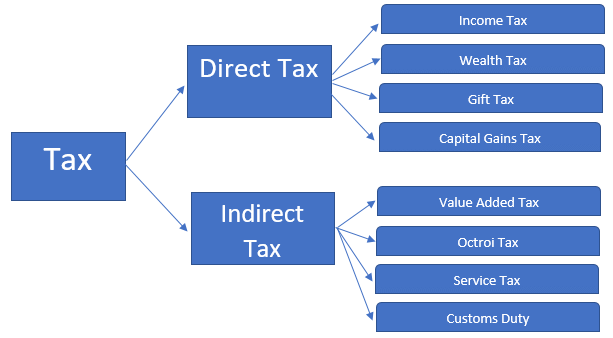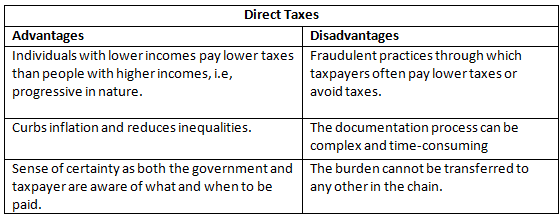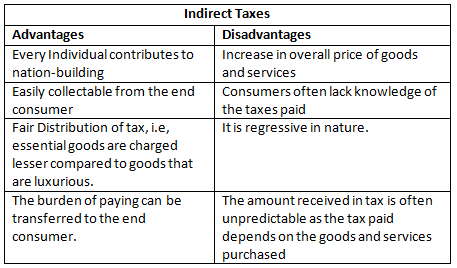Direct and Indirect Taxes | Goods and Services Tax (GST) - B Com PDF Download
| Table of contents |

|
| Introduction |

|
| Direct Taxes |

|
| Indirect Taxes |

|
| Types of Indirect Taxes and Direct Taxes in India |

|
| Difference Between Direct and Indirect Tax |

|
Introduction
In India, the tax system is organized into three levels: local municipal bodies, state governments, and the central government. Taxes in India are mainly divided into two categories: direct taxes and indirect taxes. Let's explore these two types of taxes and understand the differences between them.
Direct Taxes
Direct taxes are imposed on the income or profits of individuals and entities. For instance, when a taxpayer pays the government various taxes such as income tax, personal property tax, or fringe benefit tax (FBT), they are fulfilling their obligation under direct tax laws. The key characteristic of direct taxes is that the burden of the tax falls on the person or entity on whom it is levied, and it cannot be passed on to someone else. The Central Board of Direct Taxes (CBDT) is responsible for governing and administering direct taxes in India.
Indirect Taxes
Indirect tax is imposed by the government on goods and services. This type of tax can be shifted from one taxpayer to another. For example, a wholesaler can pass the tax on to retailers, who then pass it on to customers. Ultimately, it is the customers who bear the burden of indirect taxes. The Central Board of Indirect Taxes and Customs (CBIC) is responsible for governing and administering indirect taxes.
Other Taxes
- Income Tax: Tax on individual or corporate income.
- Sales Tax: Tax on sales of goods and services, often included in the final price.
- Property Tax: Tax on real estate properties, based on their assessed value.
- Corporate Tax: Tax on the profits of corporations.
- Service Tax: Tax on services provided, usually by service providers to consumers.
- Registration Fees: Fees for registering various documents or properties, such as real estate.
- Securities Transaction Tax: Tax on the transaction of securities, such as stocks and bonds.
- Octroi Duty: Tax on goods brought into a municipal area for consumption.
- Toll Tax: Fee for using certain roads, bridges, or tunnels.
- Capital Gains Tax: Tax on the profit from the sale of capital assets, such as stocks or real estate.
- Custom Duty: Tax on the import or export of goods across international borders.
- Education Cess: Additional tax for funding education, usually levied on income or other taxes.
- Gift Tax: Tax on the value of gifts received above a certain threshold.
- Value Added Tax (VAT): Tax on the value added to goods and services at each stage of production or distribution.
- Entertainment Tax: Tax on entertainment activities, such as movies, concerts, and events.
- Wealth Tax: Tax on the net wealth of individuals or entities, based on their assets.
- Goods & Services Tax (GST): Comprehensive tax on the supply of goods and services, combining various indirect taxes.
- Professional Tax: Tax on professions, trades, or employment, usually levied by local authorities.
Types of Indirect Taxes and Direct Taxes in India

Indirect Taxes:
- Goods and Services Tax (GST): GST is an indirect tax applied to various goods and services. A key advantage of GST is its ability to eliminate the cascading effect of tax-on-tax, which was prevalent in the previous tax system.
- Excise Duty: This tax is imposed on the licensing, sale, or production of certain goods manufactured within the country.
- Sales Tax: Sales tax is charged by the seller to the buyer when selling or exchanging a taxable good. The seller is responsible for remitting this tax to the government on behalf of the buyer. The specific sales tax applicable can vary based on the authority in power and its policies. Examples of sales tax types include manufacturer’s sales tax, wholesale sales tax, use tax, value-added tax, and retail sales tax. However, with the advent of GST, state and central sales tax on most goods and services has been replaced by GST.
Direct Taxes:
- Income Tax: Income tax is levied on the profits and income earned during a financial year. It is a common example of a direct tax, imposed by the Central government on the income generated by individuals and businesses. The amount of income tax payable depends on the level of income earned under various heads and applies to those with an annual income exceeding the basic exemption limit.
- Other Examples: Other examples of direct and indirect taxes include corporate tax, value-added tax, customs duty, and more.
- Understanding the Pros and Cons: It is important to understand the advantages and disadvantages of direct and indirect taxes now that you are familiar with some common types of these taxes.
Advantages And Disadvantages Of Direct Tax

Advantages And Disadvantages Of Indirect Tax

Difference Between Direct and Indirect Tax
Direct Tax:
- Tax on income or wealth: Direct taxes are levied on the income or wealth of individuals and organizations. Examples include income tax, corporate tax, and wealth tax.
- Progressive in nature: Direct taxes are usually progressive, meaning that the tax rate increases as the income or wealth of the taxpayer increases. This aims to reduce income inequality.
- Tax burden: The tax burden cannot be shifted in direct taxes. The person who pays the tax to the government cannot recover it from someone else. For example, if an individual pays income tax, they cannot pass on that cost to someone else.
Indirect Tax:
- Tax on goods or services: Indirect taxes are levied on the production, sale, or consumption of goods and services. Examples include goods and services tax (GST), value-added tax (VAT), and excise duty.
- Regressive in nature: Indirect taxes are often regressive, meaning that they take a larger percentage of income from lower-income individuals compared to higher-income individuals. This is because these taxes are applied uniformly regardless of the taxpayer's income level.
- Tax burden: The tax burden can be shifted in indirect taxes. The person paying the tax can pass on the cost to another person. For example, a retailer may include the cost of sales tax in the price of goods sold to customers.
|
19 videos|83 docs|14 tests
|
FAQs on Direct and Indirect Taxes - Goods and Services Tax (GST) - B Com
| 1. What are Direct Taxes and how do they differ from Indirect Taxes? |  |
| 2. What are some common examples of Indirect Taxes? |  |
| 3. What are the main features of Indirect Taxes? |  |
| 4. Why are Direct Taxes considered more equitable than Indirect Taxes? |  |
| 5. How do Direct and Indirect Taxes impact economic behavior? |  |















